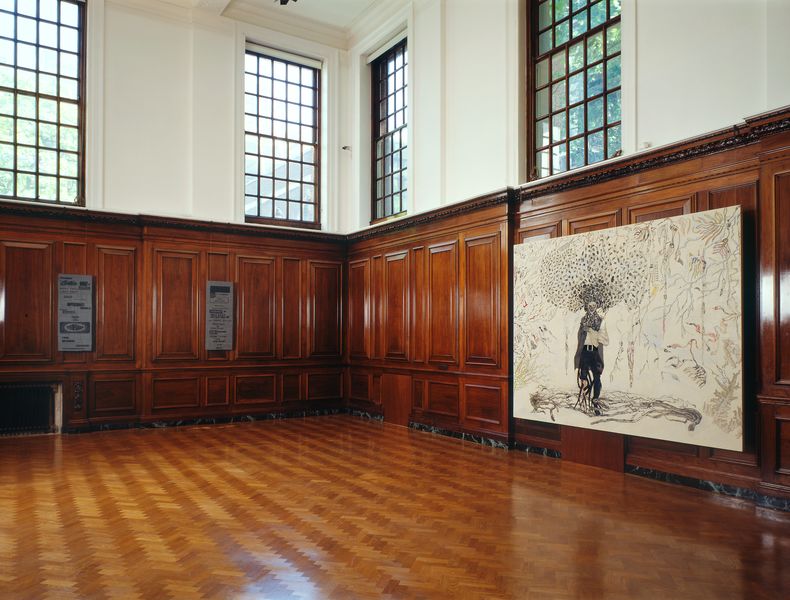
Ellen Gallagher
Salt Eaters
7 June - 22 July 2006
London
Ellen Gallagher’s art explores issues of race, identity and transformation. Renowned for her reworking of popular black imagery, Gallagher draws on postwar magazines and advertising, as well as film and music culture. She makes repeated reference to the traditions of minstrelsy, as well as to specific performers such as vaudeville star Bert Williams and jazz musician Sun Ra. Pages from mid-century black photomagazines such as Ebony, Our World and Sepia - all dominated by advertisements for Afro hairstyles, wigs and skin products aimed at African-American women - are often cited in her investigation of the anxieties and tensions surrounding black identity in the age of consumerism. Historically specific cultural references are merged with Gallagher’s own personal biography as a black Irish American woman. Her imagery combines densely patterned surfaces in grid format with intricate biomorphic forms. On closer inspection, these are revealed to be accumulations of stylised eyes and mouths, signs drawn from the historical caricatures of the black body. Appropriating these stereotypical signifiers of identity, she subverts them by a meticulous process of repetition and revision, offering a new and poetic mode of representation.
Gallagher's recent works display a particular fascination with the history of the islands of Cape Verde and their volcanic landscape that was for centuries the scene of trade in salt and slaves. Gallagher refers to the gathering of salt, the 'white gold' upon which the Cape Verde communities were built. Her works are infused with a sense of alchemy. They reveal an interest in transformation, the process by which those who were forced to dig for salt and load ships slowly adopted the guise of their oppressors; a process whereby slaves, now proficient sailors and expert navigators, rose to become captains of weathered trading vessels. Multiple strands of meaning are woven into Gallagher's work, fusing this specific historical narrative with a personal perspective based on the artist's findings. This sense of metamorphosis extends to the techniques that Gallagher harnesses in her work. Though described as paintings, Gallagher’s works are built up in layers of varied materials, including pen, pencil, paint, collaged paper and newsprint, oil, and plasticine. Her technique of production is intensely physical; the works are created over painstaking periods of time, their materials scored, scratched and gouged.
Ellen Gallagher (b. 1965, Providence, Rhode Island) lives and works in New York and Rotterdam. Gallagher's work will be shown at the Institute of Contemporary Arts, London, as part of the forthcoming exhibition Alien Nation. This summer, her film Murmur will be shown at Art Basel Unlimited. Already this year, Gallagher's work has been included in the critically acclaimed exhibition Infinite Painting, curated by Francesco Bonami at Villa Manin, Italy. In March 2006, Gallagher's DeLuxe was shown at Hauser & Wirth Zurich. Other recent solo museum exhibitions include: DeLuxe, Whitney Museum of American Art, NY (2005); Murmur and DeLuxe, MOCA, Miami (2005); and Ichthyosaurus, The Freud Museum, London (2005). Gallagher studied at Oberlin College, OH (1982-84); Studio 70, Fort Thomas, KY (1989); School of the Museum of Fine Arts, Boston, MA (1992); and at Skowhegan School of Art, ME (1993). In 2000 she was awarded the American Academy Award in Art and in 2003 was selected for the Venice Biennale.
Installation views


About the Artist

Ellen Gallagher
Born in Providence, Rhode Island, Ellen Gallagher lives and works between Rotterdam, Netherlands and New York. Gallagher builds multi-layered paintings that pivot between the natural world, mythology and history. Her painting process involves undoing and reforming trains of thought often over long periods of time and across linked bodies of works. Over a highly multifaceted career, Gallagher’s work has been united by what she calls a ‘jitter,’ an intellectual approach in which aesthetic possibilities are shook loose from seismic cracks beneath the surface of cultural entities normally thought to be unshakable and impermeable. Encompassing painting, drawing, collage and celluloid based projections that fuse technique and material into syncretic form, her arresting compositions are a process of recovery and reconstitution through the accumulation and erasure of media, which results in palimpsestic and topographic surfaces.
The subtle textures of her paintings bear witness to a singular process that is materially and conceptually intertwined. Gallagher creates a geographic timeline in which interlocking forms appear to mutate between figuration and abstraction, like agents in a musical composition coming together in an evolving continuum. Gallagher’s work is included in many major international museum collections including MoMA, New York; Albright Knox Art Gallery, Buffalo; The Metropolitan Museum of Art, New York; The Art Institute of Chicago; MCA Chicago; MOCA, Los Angeles; Philadelphia Museum of Art; Whitney Museum of Art, New York; Tate, London; and Centre Pompidou, Paris.
Current Exhibitions
1 / 12











